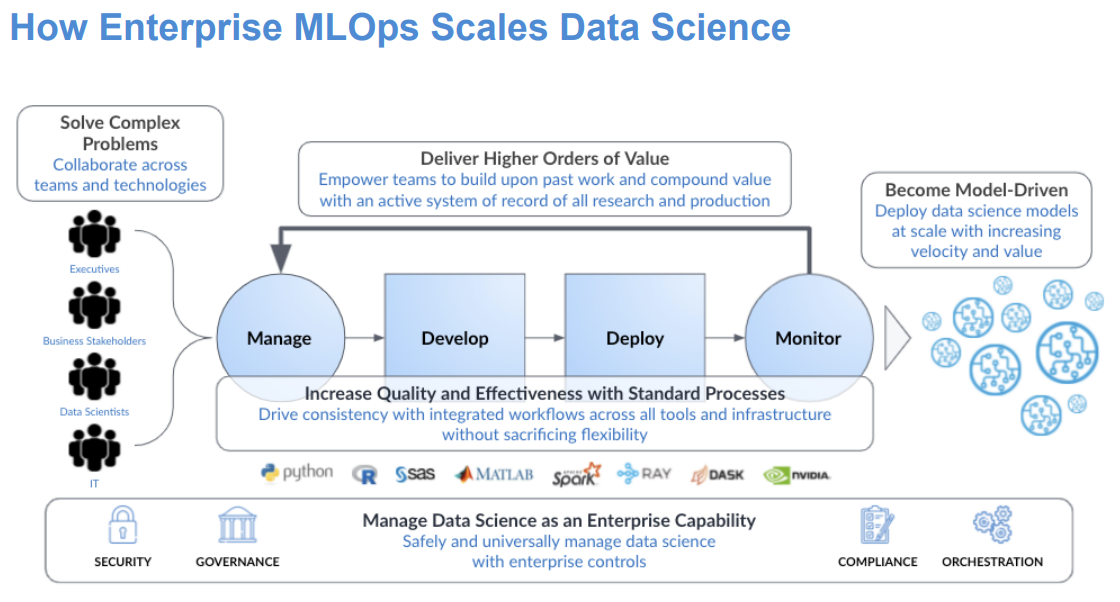How Enterprise MLOps Turbocharges Data Science: 4 Real-World Use Cases
Josh Poduska2022-03-07 | 9 min read

Today’s businesses are investing heavily in data science – spending on software, hardware and services is projected to break the $500 billion mark by 2024, according to IDC. Data science models with machine learning (ML) and artificial intelligence (AI) techniques have proven their worth at forging new revenue streams and upending entire industries. For a model-driven business, new revenue from such use cases can range from hundreds of millions to billions of dollars. At successful companies, leaders have built a well-oiled analytical flywheel to create a steady flow of models that can tap this new gold rush.
With intense competitive pressures, the push for scaling data science use cases makes sense from a business leader’s perspective. But if you’re feeling the heat, it’s worth exploring how Enterprise MLOps principles can enable better models for your company’s needs–by speeding up each stage of the data science lifecycle.
Accelerating the Data Science Lifecycle with Enterprise MLOps: 4 Use Cases
In our extensive work with enterprise MLOps projects, we’ve noticed that four use cases constitute the most common functions that businesses need to accelerate. This blog defines Enterprise MLOps and describes these four Enterprise MLOps use cases that illustrate key principles important to the four stages of the data science lifecycle:
- Managing Data Science Projects
- Developing Models for Business Use Cases
- Deploying Models for Production
- Monitoring the Model Portfolio for Ongoing Performance
Let’s look at some real-world MLOps examples that illustrate the gains that Enterprise MLOps makes possible in each stage of the data science lifecycle.
What is Enterprise MLOps? And How Does It Help Scale Data Science?
Domino Data Lab has collaborated with many companies–across many industries, including finance and insurance–that have built a revenue-generating data science machine at scale. One thing they all have in common is a holistic approach that looks for efficiencies of scale across all stages of the data science lifecycle – including the front-end stages of research and development. We call this approach Enterprise MLOps: a set of technologies and best practices that streamline the management, development, deployment, and monitoring of data science models at scale across a diverse enterprise. Enterprise MLOps is an extension of the older term, MLOps, which refers to a narrower focus of backend deployment and maintenance of models.

4 Use Cases for Enterprise MLOps
The principles of Enterprise MLOps are found in each stage of the data science lifecycle. There are 19 principles in all – far too many for this blog! For now, let’s illustrate the results of using these principles in four MLOps use cases in the whitepaper– one for each stage of the data science lifecycle.
Use Case 1: How SCOR Manages Models Better through Collaboration
SCOR, the world’s fourth largest reinsurer, helps clients control and manage risk—natural risks, climate risks, health risks, geopolitical risks, cyber risks, and many others. And they help people rebuild when adversity occurs.
To improve efficiencies in the Manage stage, SCOR focused on collaborative best practices that could be reused from one project to another and brought a systematic approach to the early stages of creating an application or API. SCOR leveraged new technologies to ensure the enterprise would achieve the kind of knowledge sharing they envisioned.
Antoine Ly, Head of Data Science at SCOR, describes the effort and its results.
“To share knowledge, practices, and code, we have to share tools. To this end, we’ve implemented a multi-cloud strategy and platform,” says Ly.
“For example, we launched a dashboarding initiative,” he says. “We’re expanding on some existing dashboards to monitor the data and control some of the different models so that other markets can take advantage of them. We’ve already made one developed in Australia available to the European and US markets. We’ve also used the platform to extend the use of an API developed in Europe to make it available worldwide.”
Use Case 2: How MLOps Helps a Fortune 500 Global Financial Services Leader Develop Models Faster
Model building is the core function of data science work. Development requires access to tools and infrastructure such as powerful compute resources, high-value and sensitive data, and the latest open-source tools and packages to support diverse experiments. Obstacles to using such resources were slowing efforts by a Fortune 500 global financial services leader to scale its data science practice across the enterprise.
In this MLOps example, the company’s Analytics Center of Excellence made it a priority to reduce overall time for development of models. The company adopted an Enterprise MLOps platform to streamline collaborative development of models by teams spread across different geographies. With the adoption of Enterprise MLOps, the financial services company enabled faster development at scale without compromising IT security requirements.
The result?
“Enterprise MLOps helps us bring our distributed team together in a collaborative way so we can operationalize data science, at scale, across the company,” says a Senior IT Architect at the financial services company.
Use Case 3: Enterprise MLOps Helps Moody’s Deploy Production Machine Learning-based Risk Models
Finding a robust Enterprise MLOps solution that could improve model deployment was an important goal for Moody’s, the New York-based company that supplies expertise and tools such as data, models, software, and professional services to help customers grow efficiently and manage financial risk. “The cost of improving or replacing a model was too high,” said Jacob Grotta, General Manager of the Banking Operating Unit. In a competitive industry, the company needed a standardized way to deploy models.
Using the technology and principles of Enterprise MLOps for model deployment, data scientists were able to develop an API and share it with customers for beta testing within a few days. In this MLOps example, they used feedback to make adjustments and redeploy the model almost instantly, eventually embedding it into a product release. “Rather than taking a year, the process took a couple of months, and the cost of deployment was much lower,” Grotta said. That’s a 6X performance acceleration.
Moody’s can now efficiently deliver customized models for risk and other analytics that help run large-scale enterprises, and cost-effectively deploy them according to customer preferences, either on premises, in the cloud, or as SaaS. Data scientists at banks can now deploy new models on their own, saving time and adding value to the business.
Use Case 4: Large European Insurer Topdanmark Uses MLOps to monitor and Detect Data & Model Drift
Improving its model monitoring capability was one motivation for Topdanmark’s move to Enterprise MLOps. Topdanmark is a large European insurance company based in Denmark. It infuses data science across its operations to provide consumers with a better, faster insurance experience.
The company adopted Enterprise MLOps technology and practices to get insights into how models are performing in real time, and to detect data and model drift once models are in production.
“Data drift can have a critical impact on predictions and ultimately, our business,” said Stig Pedersen, the company's head of machine learning. He noted that their new approach, “saves us significant time previously spent on maintenance and investigation; and enables us to monitor model performance in real time and compare it to our expectations.” In one case, the team was able to automatically detect drift that had previously taken three months to identify manually.
Getting Started with Enterprise MLOps in Your Organization: Use Cases for the ‘Analytical Flywheel’
In these MLOps examples, we’ve seen how enterprise MLOps allows a model-driven business to power an analytical flywheel, which lets leaders act dynamically and decisively to leverage valuable insights and harvest an ever-growing flow of collective wisdom. If your organization aspires to the rewards of doing data science at scale, we invite you to read our whitepaper or see our MLOps best practices guide.
It provides details on each of the 19 principles comprising the four stages of the data science lifecycle. It also contains more background on the four case studies described above.
Josh Poduska is the Chief Field Data Scientist at Domino Data Lab and has 20+ years of experience in analytics. Josh has built data science solutions across domains including manufacturing, public sector, and retail. Josh has also managed teams and led data science strategy at multiple companies, and he currently manages Domino’s Field Data Science team. Josh has a Masters in Applied Statistics from Cornell University. You can connect with Josh at https://www.linkedin.com/in/joshpoduska/



